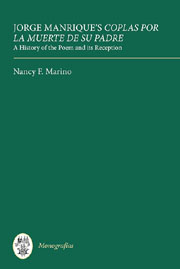Book contents
- Frontmatter
- Contents
- Dedication
- Acknowledgements
- Preface
- Chapter 1 The Author and His work
- Chapter 2 The Renaissance and Baroque Eras
- Chapter 3 Reception in the Eighteenth to Twenty-First Centuries
- Chapter 4 Shifting Literary Perspectives
- Afterword
- Appendix A Five Centuries at a Glance: A Selection of Comments about the Coplas
- Appendix B Additional Literary Responses since 1800
- Bibliography
- Index
Appendix B - Additional Literary Responses since 1800
Published online by Cambridge University Press: 05 February 2013
- Frontmatter
- Contents
- Dedication
- Acknowledgements
- Preface
- Chapter 1 The Author and His work
- Chapter 2 The Renaissance and Baroque Eras
- Chapter 3 Reception in the Eighteenth to Twenty-First Centuries
- Chapter 4 Shifting Literary Perspectives
- Afterword
- Appendix A Five Centuries at a Glance: A Selection of Comments about the Coplas
- Appendix B Additional Literary Responses since 1800
- Bibliography
- Index
Summary
In “Literary Responses since 1800” (pp. 127–34) I discussed some of the most important, interesting, or unique texts that have been informed by Jorge Manrique's Coplas since the nineteenth century. The following list of additional works in this category – probably not exhaustive – offers the interested reader a point of departure for further inquiry. Unless otherwise noted, the works are poems; they have been organized in chronological order by the dates of the authors' lives. What is immediately evident is that the Coplas por la muerte de su padre has remained a constant inspiration for poets of the Spanish-speaking world for more than 200 years, and continues to stir the creative impulse of contemporary writers.
José María Heredia (1803–39): “Niágara,” and “A Washington”
José de Espronceda (1808–42): “Canto a Teresa”
Gertrudis Gómez de Avellaneda (1814–73): “A la muerte del célebre poeta cubano don José María de Heredia”
José Zorrilla (1817–93): “El reloj”
Ramón de Campoamor (1817–1901): “Lo que hace el tiempo”
Ricardo Palma (1833–1919): the tradición “Una aventura amorosa del Padre Chuecas”
Rosalía de Castro (1837–85): “Hora tras hora, día tras día”
Manuel Reina (1856–1905): “El jardín de los poetas”
José Asunción Silva (1865–96): “Día de difuntos”
Amado Nervo (1870–1919): “El lirio cárdeno”
León Felipe (1884–1968): “El hacha”
Jorge Guillén (1893–1984): “Al margen de Jorge Manrique” and “Muerte”
- Type
- Chapter
- Information
- Jorge Manrique's 'Coplas por la muerte de su padre'A History of the Poem and its Reception, pp. 183 - 184Publisher: Boydell & BrewerPrint publication year: 2011

